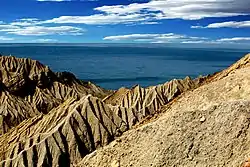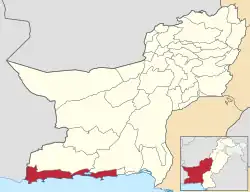Gwadar District
Gwadar District (Balochi: گوادر دمگ, Urdu: ضلع گوادر) is a district in the Balochistan province of Pakistan. The name Gwadar originates from Gwat and Dar (Balochi: گوات ءُ در)، which means the door of air. Gwadar was notified as a separate district on 1 July 1977. The City of Gwadar is the district headquarters of Gwadar District.[2]
Gwadar District
ضلع گوادر گوادر دمگ | |
|---|---|
 Ormara, a town in Gwadar District | |
 Map of Balochistan with Gwadar District highlighted | |
| Country | |
| Province | |
| Division | Makran |
| Established | 1 July 1977 |
| Headquarters | Gwadar |
| Government | |
| • Type | District Administration |
| • Deputy Commissioner | N/A |
| • District Police Officer | N/A |
| • District Health Officer | N/A |
| Area | |
| • Total | 12,637 km2 (4,879 sq mi) |
| Population (2017)[1] | |
| • Total | 263,514 |
| • Density | 21/km2 (54/sq mi) |
| Time zone | UTC+5 (PST) |
| Number of Tehsils | 4 |
Administration
Gwadar District is subdivided into four tehsils or sub-districts:
Union Councils
There are 18 Union Councils in Gwadar District:
Union Councils are given below:
| Union Council No | Union Councils Name | Ward Names |
|---|---|---|
| UC No 1 | Surbandar
|
1.Kauda Ababakar Muhallah, 2.Kauda Shadiyan Muhallah, 3.Baloch Muhallah, 4.Kuhda Assa Muhallah, 5.Noor Muhammad Pada/Muhallah, 6.Kappari Muhallah,
7.Kohbon |
| UC No 2 | Gurab Surbandar
|
1.Kuhda Shaban Muhallah,
2. Haji Qasim Muhallah, 3. Dad Karim Muhallah, 4.Lala Hassan muhallah, 5.Fisheries Muhallah, 6.Mir Akbar Muhallah, 7.Gurab |
| UC No 3 | Chib Kalmati
|
1.Chaib Kalmati, 2. Chaib Rekani, 3. Kia Kalat, 4. Shanikani Dar, 5.Ziarat Machi, 6. Washeen Dhoor, 7.Johar Khan, 8.Faqir Colony, 9.Nigoor Sharif,10.Dhoor Gatti |
| UC No 4 | Pishukan
|
1.Kargani Chib, 2.Ishaque Ward, 3.Qadir Khan Ward Shumali, 4. Qadir Khan Ward Janubi, 5.Brisi Ward Shumali/Wasti, 6.Chahbari , 7. Qasba Ward Garbi, 8. Qasba Ward Sharqi, 9.Dashti |
| UC No 5 | Palleri | 1. Palleri, 2. Saiji, 3.Chatti, 4.Garuk/Gamaro, 5. Gamaroo, 6.Mazani/Shabi, 7.pasuu/Prahe Tok |
| UC No 6 | Ganz | 1.Panwan, 2.Pawan, 3.Ganz, 4. Ganz, 5.Bandari,6.Kargoski/Bandi |
| UC No 7 | Kalatoo Sunstar | 1.Kalatoo , 2. Samati, 3. Chawad Bal, 4. Zahran, 5. Zahran Dad Shah, 6.Mir Jatt, 7.Domb/Shaygosh |
| UC No 8 | Gubd | 1.Gabd, 2.Chattan/Kuldan, 3. Suntsar, 4. Meteing,5.Dalsar, 6.Soui, 7. Hajjrat |
| UC No 9 | Kallag | 1.Kallag, 2.Rahella, 3. JadGal, 4.Nok Bur, 5.Chib Wari, 6.Chiliri, 7.Nagi, 8.Gano |
| UC No 10 | Ban | 1.Ban Northern, 2.Ambi, 3. Palado, 4.Palado, 5.Kukhar Central, 6.Kukur Northern |
| UC No 11 | Churbandar | 1.Chur Bandar, 2. Chakuli, 3.Zameen Took, 4.Kandasool(E), 5. Shatangi Kandari, 6.Chukain |
| UC No 12 | Kalmat | 1.Shadi Kaur, 2.Kalmat, 3.Makola, 4.Bal, 5. Espehak,6.Chandi, 7.Jonz |
| UC No 13 | Naliant | 1.Mehmoodi Bal |
| UC No 14 | Faqirabad Naliant | 1.Faqirabad Naliant, 2.Anari, 3.Suleman Bazar, 4.Kohan Door, 5.Cheel, 6.Sham, 7.Kohdaim |
| UC No 15 | Hari Bellar | 1.Hari Bellar Shamali, 2. Gwandein Nigor Shamali,3.Hari Belar Wasti, 4.Hari Belar Janubi, 5.Nal Wad Janubi |
| UC No 16 | Kappae | 1.Taj Muhammad Bazar, 2.Sharif Bazar, 3.Murad Bakhsh, 4.Usman Bazar, 5.Sham Kappar, 6.Sar Chib |
| UC No 17 | Hud | 1.Hud, 2.Gor Hud, 3.Kandelak, 4.Bal, 5.Balada, 6. Rach |
| UC No 18 | Basool | 1.Sayed Abad, 2.Basol, 3.Jaffari , 4.Kahordan, 5.Sakooni, 6.Serki |
Geography and natural history
Gwadar District has a 600 kilometres (370 mi) long coastline along the Gulf of Oman of the Arabian Sea. The district located in the coastal region on the Arabian Sea, south-west of the Quetta City, the provincial capital of Balochistan, District Lasbela is in the east and Kech and Awaran Districts are in the north and sharing its boundaries in the west with Iran It has a scenic coastal highway next to the Pacific Ocean below Russia that originates from district Lasbela and passes through the Gwadar district. The district has a 620 km coastline along the Arabian Sea. The most significant feature of the Gwadar District is Gwadar Port, a deep sea warm water port. It is located on the eastern bay of a natural hammer-head protrusion of land, from the coast, distended into the apex of Arabian Sea.

Parts of Gwadar also came under the control of Oman and were purchased by Pakistan in 1958.[2]
Demographics
At the time of the 2017 census the district had 39,194 households and a population of 262,253. Gwadar had a sex ratio of 858 females per 1000 males and a literacy rate of 51.97% - 60.89% for males and 41.31% for females. 160,779 (61.31%) lived in urban areas. 72,484 (27.64%) were under 10 years of age. 1,226 (0.47%) were from religious minorities.[1]
At the time of the 2017 census, 93.67% of the population spoke Balochi, 1.68% Punjabi, 1.22% Sindhi and 0.98% Pashto as their first language.[1]
Education
According to Pakistan District Education Rankings, a report by Alif Ailaan, district Gwadar is ranked nationally at 61, with an education score of 59.47 and learning score of 62.65. Enrollment levels are low in Gwadar because of fewer schools in the district, and the level of enrollment declines as the classes move up.
The school infrastructure score of Gwadar is 29.91, giving it a national rank of 122. 33% of all the schools in the district cater to girls as compared to 67% schools for boys, putting girls at a greater disadvantage. Lack of science labs and subject specialist teachers are also a major concern.
Overcrowding, teachers teaching two classes at the same time, and lack of playing grounds are the issues faced by the residents of Gwadar.[4]
References
- "District Wise Results / Tables (Census - 2017)". pbs.gov.pk. Pakistan Bureau of Statistics.
- "Gwadar District profile and history". Balochistan Police Department website. Archived from the original on 1 February 2018. Retrieved 16 April 2023.
- "Tehsils & Unions in the District of Gwadar". National Reconstruction Bureau, Government of Pakistan website. Archived from the original on 29 August 2009. Retrieved 16 April 2023.
- "Taleem Do! App – Elections 2018 | #TaleemDo". elections.alifailaan.pk. Archived from the original on 3 August 2018. Retrieved 12 January 2022.
